|
Today
we finally got on our way to Tokyo. At the
Sendai station we were waiting for our
train arriving on time as
usual.
Wow!
This time we were really lucky. The modern
MAX Super Express `Yamabiko` should bring
us to the megametropolitan
Tokyo.
With
a top speed of more than 320 km/h it took
us in appr. 2 hours to our
destination.
We
barely felt the speed inside the
comfortable compartment. Only when passing
one of the many tunnels we felt strong
pressure in our ears.
|
|
|
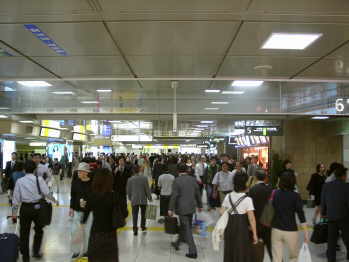
|
At
Tokyo main station we tried to find the
right way to the exit.
Although
we knew that some 20 mio people live and
work in this area, we were quite amazed by
the huge number of people at the station.
We experienced a place that was far more
busy than Atlanta airport in its busiest
time.
Once
we exited the station, we recognized
something was different - compared to good
old Germany -. Noone bumped into us ! This
barely happens here at all - as Japanese
are polite enough to slow down rather than
risking to bump into anyone.
|
|
As
a cutural highlight we choose to visit the
Meiji Shrine - one of the most famous
places besides the Asakusa Kannon
temple.
Here
you can also find the tomb of the emperor
Meiji.
The
beautiful buildings and gardens are a
popular place to go for Japanese and
foreigners as well and a favorite
`marriage temple`.
We
were lucky to witness this young couple
after the ceremony.
The
uniform of the Shinto-priests reminded us
of a costume from an older
StarWars-episode.
|
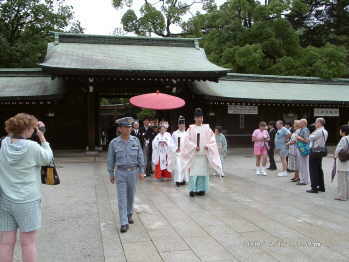
|
|
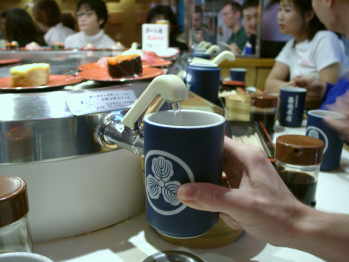
|
Back
from Meiji shrine we were hungry once
again. Today it was definitely time for
Kaiten-Sushi, the Fast Food version of raw
fish.
First
we had to stand in line in front of the
restaurant. Then there ws another stop at
the entrance when we were shown a sign in
english language explaining the conditions
for entry:
1) Eat at least 5 dishes
2) Eat fast if many people are waiting
3) Finish 5 - 6 plates in max. 10 minutes,
10-12 plates in max. 20
minutes.
Inside
the restarurant we had to sit and wait on
a long bench until we were escorted to our
seats. Then we finally got
going:
For
free tea take a cup, a tea bag and hot
water (see left).
|
|
The
time limit forced us to start eating right
away. Five Sushi chefs produced the little
ricedishes in an assembly line
fashion.
The
Sushi conveyorbelt ran with many curves
through the restaurant to serve about 50
customers with this japanese
specialty.
Kaiten-Sushi
is about as popular for japanese as
McDonalds is for Americans.
|
|
|
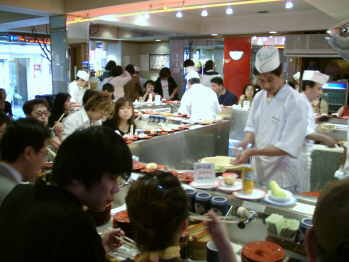
|
The
low price of 100 Yen (appr. 1 US-$) per
plate with two pieces of sushi ranging
from shrimp and tuna to different types of
clams and egg-omelette is only profitable
when sold in big quantities.
The
restaurant was visited by many young
japanese as it is one of the most famous
Kaiten-Sushi restaurants in
Tokyo.
For
your own Kaiten-Sushi experience visit the
restaurant at:
Tsukiji
honten
24-8 Udagawa-cho
Shibuya-ku, Tokyo
(closely located to Shibuya
Station)
|
|
As
we explored Shibuya we noticed a commons
species of young ladies.
Many
of them with blond (or red-brownish) hair
and a height of appr. 5`8 feet their
appearance was almost european.
After
a closer study we found more similarities
amongst those girls.
They
uniformly dress with up to 10 inch high
heeled boots, Louis Vuitton bags or
backpacks, heavily applied makeup with
glitter over the eyebrows and bared a lot
of skin.
While
such girls would probably be categorized
as party-chicks elsewhere, they seem to be
very hip in Japan.
|
|
|
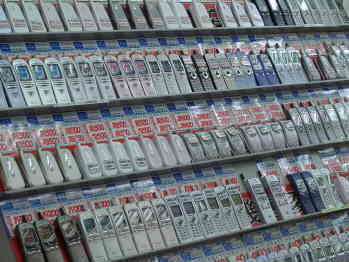
|
We
also concluded that the mobile phone is a
very important tool for young
japanese.
Without their mobile, they would not be
able to socially interact any
more.
On
every street corner, in every train and
almost all stores and restaurants several
teens and twens are busy talking on their
mobile or writing short
messages.
Eventhough
this is a trend we also experience in
Germany nowadays, japanese are well ahead
in this respect.
|
|
The
intersection in front of Shibuya station
is quite a nice sight all day (and night)
long:
All
pedestrian signals change to green at the
same time and each time hundreds or
thousands of people cross the streets in
all driections.
You
are also allowed to cross diagonally - You
can not imagine the pedestrian traffic day
and night. Actually, we were not the only
ones with this opinion - we saw a few
other `gaijin` (foreigners) who videotaped
this intersection.
|
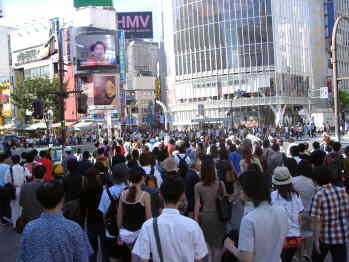
|
|
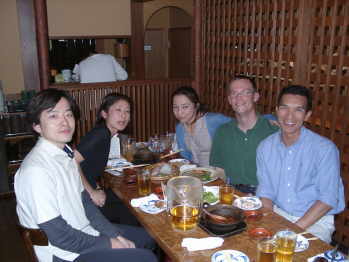
|
After
three pitchers of tasty japanese beer
shared with Hiroeís friends we
started to feel much better (as you may be
able to see)
At
this time the daily work of writing the
travel report was far from our minds, but
reality cought up with us as we arrived at
home quite late that night.
|
|
|
|
|
Our
daily special:
`The
Puzzler` (Are you a Japan
expert?)
New
impressions and curiosities as a daily Q
& A.
8)
What is the object on the photo
?
(Answer:
just click on the photo)
|
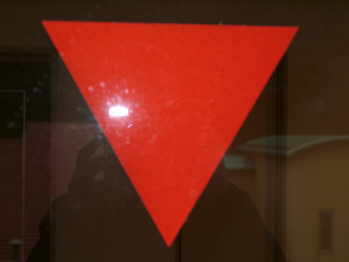
|